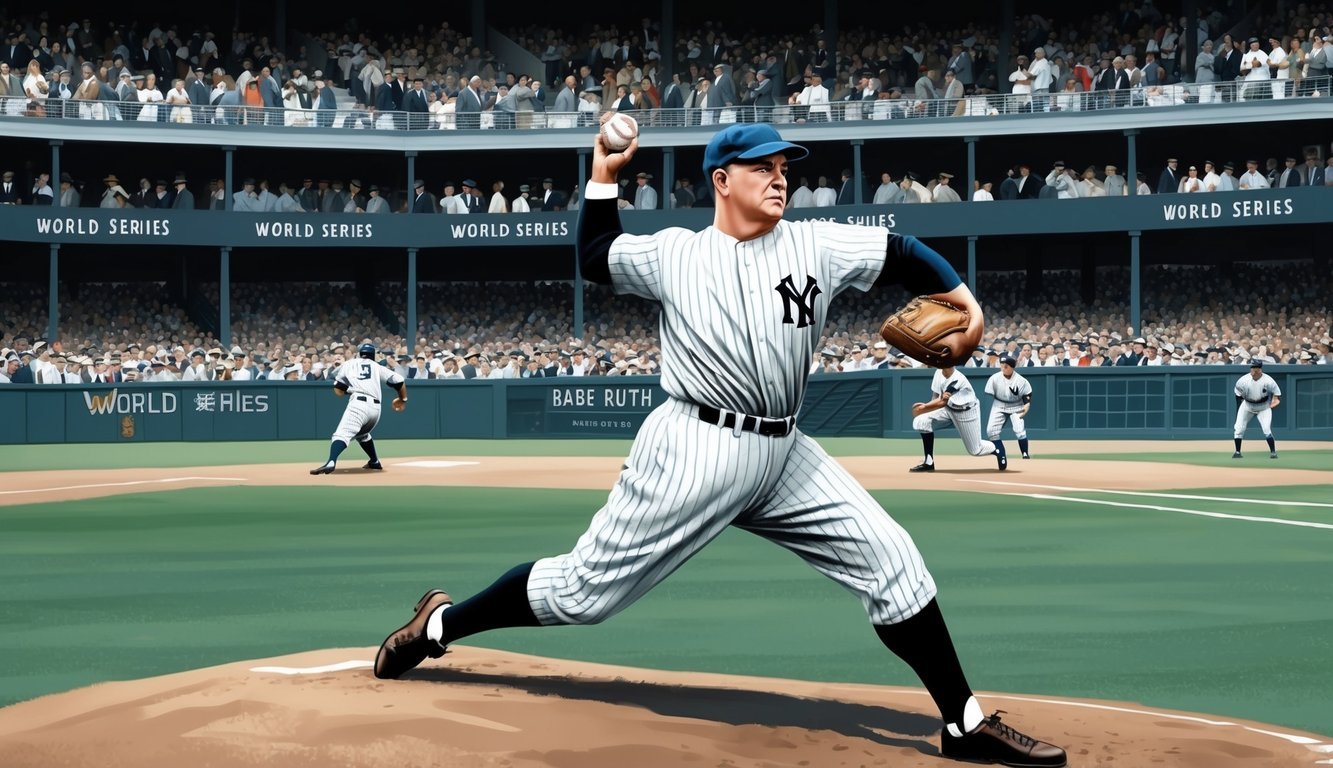Babe Ruth, the iconic baseball legend, is renowned for his incredible hitting prowess.
Yet many fans may not realize that he began his career as a pitcher.
Ruth’s pitching stats tell a fascinating story of his early years in Major League Baseball.
Babe Ruth amassed an impressive 94-46 win-loss record with a 2.28 ERA during his pitching career from 1914 to 1919. These numbers showcase his dominance on the mound before he transitioned to become one of the greatest hitters in baseball history.
Ruth’s pitching achievements include leading the American League with a 1.75 ERA in 1916.
He also pitched 29 2/3 consecutive scoreless innings in World Series play, a record that stood for 43 years.
These remarkable stats demonstrate Ruth’s versatility and highlight why he’s considered one of the most complete players ever to grace the diamond.
Early Life and Entry into Major League Baseball

George Herman “Babe” Ruth was born in Baltimore, Maryland on February 6, 1895.
His journey to becoming a baseball legend began at St. Mary’s Industrial School for Boys, where he honed his skills and caught the attention of scouts.
Transition from Outfielder to Pitcher
Ruth signed with the Baltimore Orioles, a minor league team, in 1914.
He quickly impressed with his pitching abilities.
The Boston Red Sox soon purchased his contract, recognizing his potential on the mound.
Ruth made his MLB debut on July 11, 1914, at just 19 years old.
He started as a pitcher but also showed promise as a hitter.
The Red Sox began using him as an outfielder when he wasn’t pitching to keep his bat in the lineup.
First Seasons and Development
Ruth’s first full season with the Red Sox was in 1915.
He posted an impressive 18-8 record with a 2.44 ERA.
His pitching skills continued to improve over the next few years.
In 1916, Ruth led the American League with a 1.75 ERA.
He won 23 games that season, establishing himself as one of the best left-handed pitchers in baseball.
Ruth’s pitching success continued in 1917 and 1918.
He won 24 games in 1917 and helped the Red Sox win the World Series in 1918 with two victories on the mound.
Pitching Career Overview
Babe Ruth’s pitching prowess often gets overshadowed by his legendary hitting, but his mound skills were remarkable.
He dominated as a left-handed pitcher for the Boston Red Sox from 1914 to 1919, showcasing exceptional talent and consistency.
Seasonal Performance
Ruth’s pitching career peaked from 1915 to 1918.
In 1915, he posted a 2.44 ERA over 217.2 innings.
The 1916 season was even better, with Ruth leading the American League with a 1.75 ERA.
He threw an impressive 323.2 innings that year.
In 1917, Ruth won 24 games, his career-high.
He maintained a strong 2.01 ERA over 326.1 innings.
In the championship year of 1918, Ruth went 13-7 with a 2.22 ERA in 166.1 innings.
His career pitching stats include:
- Wins: 94
- ERA: 2.28
- Strikeouts: 488
- Innings Pitched: 1,221.1
Notable Games and Innings
Ruth’s pitching brilliance shone in several memorable games.
On June 23, 1917, he threw a no-hitter against the Washington Senators.
The game lasted just 1 hour and 51 minutes.
In the 1918 World Series, Ruth pitched 29 1/3 consecutive scoreless innings.
This record stood for 43 years until Whitey Ford broke it in 1961.
Ruth’s longest outing came on September 4, 1916.
He pitched all 14 innings of a 2-1 victory over the Philadelphia Athletics.
Pitching Techniques and Style
Ruth’s pitching style combined power and finesse.
He relied on a blazing fastball as his primary weapon.
His curveball was also effective, keeping hitters off-balance.
Ruth’s tall frame (6’2″) allowed him to throw with a downward plane.
This created challenging angles for batters.
He had excellent control, walking only 2.9 batters per nine innings over his career.
His pitching motion was smooth and effortless.
Ruth often appeared relaxed on the mound, adding to his intimidating presence.
He was known for working quickly between pitches, keeping fielders alert and batters uncomfortable.
Statistical Achievements and Records
Babe Ruth’s pitching career was remarkable, with impressive numbers across multiple categories.
His performances on the mound set several records and milestones that showcased his versatility as a player.
Ruth not only dominated as a pitcher but also laid the groundwork for his legendary hitting career, which ultimately overshadowed his early accomplishments on the mound.
The “Babe Ruth Called Shot legacy” remains a testament to his larger-than-life presence in baseball, captivating fans with his charisma and boldness.
His dual-threat capabilities redefined what it meant to be a baseball player, inspiring countless athletes to embrace a multifaceted approach to the sport.
Career Milestones
Ruth achieved 94 wins as a pitcher, with a career ERA of 2.28.
He struck out 488 batters and completed 107 games.
In 1916, he led the American League with a 1.75 ERA.
Ruth’s best season as a pitcher came in 1916 when he went 23-12 with 9 shutouts, setting a record for left-handed pitchers that stood until 1978.
He pitched 29 2/3 consecutive scoreless innings in World Series play, a record that lasted until 1961.
Ruth’s career pitching WAR (Wins Above Replacement) was an impressive 20.6.
Wins and Losses
Ruth’s win-loss record as a pitcher was 94-46, giving him a .671 winning percentage.
His best season for wins was 1916, with 23 victories.
In 1917, he went 24-13, his highest win total.
Ruth had six 20-win seasons in his career.
His lowest ERA in a season was 1.75 in 1916.
He never had a losing season as a starting pitcher.
Home Runs as a Pitcher
Despite primarily being known for his hitting, Ruth hit 14 home runs while playing as a pitcher.
This was unusual for the era, as pitchers rarely contributed offensively.
In 1918, Ruth hit 11 home runs while making 20 pitching appearances.
This dual-threat ability foreshadowed his transition to a full-time outfielder.
Ruth’s prowess at the plate as a pitcher helped convince the Red Sox to move him to the outfield to take advantage of his batting skills.
Team Contributions and World Series Appearances

Babe Ruth’s impact on baseball extended far beyond his individual achievements.
His performances in the World Series and contributions to multiple teams solidified his legendary status in the sport.
Performance with the Boston Red Sox
Ruth began his career with the Boston Red Sox in 1914.
He quickly became a dominant pitcher, helping the team win three World Series titles in 1915, 1916, and 1918.
In the 1916 World Series, Ruth pitched a remarkable 14-inning complete game victory against the Brooklyn Robins.
His batting skills also emerged during this time.
Ruth transitioned from pitcher to outfielder to take advantage of his powerful hitting.
By 1919, he set a single-season home run record with 29, showcasing his value as a hitter.
Ruth’s Role in World Series Victories
After joining the New York Yankees in 1920, Ruth’s World Series legacy grew.
He led the Yankees to four World Series championships in 1923, 1927, 1928, and 1932.
Ruth’s World Series stats were impressive, with a .326 batting average, 15 home runs, and 33 RBIs in 41 games.
His most famous World Series moment came in 1932 when he allegedly “called his shot” before hitting a home run against the Chicago Cubs.
This iconic moment added to Ruth’s mystique as the “Sultan of Swat.”
Ruth’s final World Series appearance came in 1932, capping off a career that saw him win seven championships across two American League teams.
His performances in these high-stakes games cemented his reputation as one of baseball’s greatest players.
Legacy and Impact on Baseball

Babe Ruth’s influence on baseball extended far beyond his pitching accomplishments.
His larger-than-life persona and incredible hitting prowess transformed the sport and captivated fans across America.
Ruth as a Baseball Icon
The Bambino became the face of baseball in the 1920s and 1930s.
His charisma and prodigious home runs drew record crowds to ballparks.
Ruth’s nickname “Sultan of Swat” reflected his unparalleled power at the plate.
Media coverage of Ruth’s exploits helped baseball recover from the 1919 Black Sox scandal.
His popularity made him one of the first true sports celebrities.
Even today, Ruth remains synonymous with baseball greatness.
ESPN and other outlets regularly feature him in discussions of all-time greats.
Comparisons to Other Pitchers
As a pitcher, Ruth’s numbers stack up impressively against his contemporaries.
His 2.28 career ERA ranks among the best in baseball history.
Ruth’s pitching achievements are often overshadowed by his hitting, but he was truly elite on the mound.
His dominance rivaled that of Walter Johnson, considered by many the greatest pitcher of the era.
Ruth’s Influence Beyond the Mound
Ruth’s transition from ace pitcher to slugging outfielder changed baseball strategy.
His home run hitting prowess ushered in a new offensive era.
The American League’s surge in popularity during Ruth’s prime was largely attributed to his star power.
His salary demands also pushed player compensation to new heights.
Ruth’s charitable work, especially with children, enhanced his iconic status.
His larger-than-life personality made him a cultural figure.
